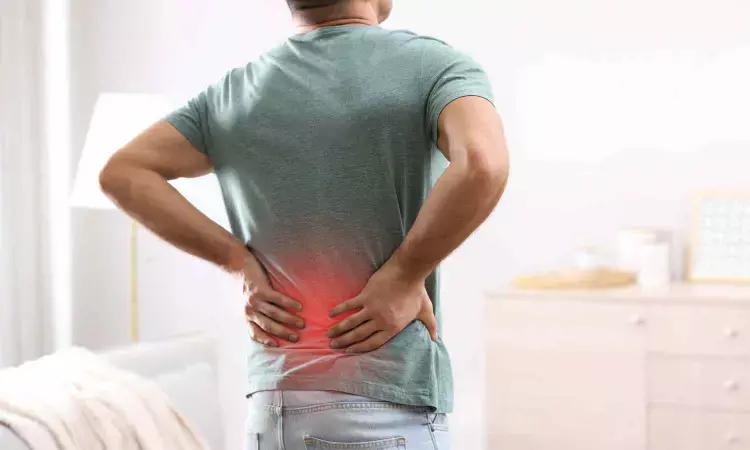- Home
- Medical news & Guidelines
- Anesthesiology
- Cardiology and CTVS
- Critical Care
- Dentistry
- Dermatology
- Diabetes and Endocrinology
- ENT
- Gastroenterology
- Medicine
- Nephrology
- Neurology
- Obstretics-Gynaecology
- Oncology
- Ophthalmology
- Orthopaedics
- Pediatrics-Neonatology
- Psychiatry
- Pulmonology
- Radiology
- Surgery
- Urology
- Laboratory Medicine
- Diet
- Nursing
- Paramedical
- Physiotherapy
- Health news
- Fact Check
- Bone Health Fact Check
- Brain Health Fact Check
- Cancer Related Fact Check
- Child Care Fact Check
- Dental and oral health fact check
- Diabetes and metabolic health fact check
- Diet and Nutrition Fact Check
- Eye and ENT Care Fact Check
- Fitness fact check
- Gut health fact check
- Heart health fact check
- Kidney health fact check
- Medical education fact check
- Men's health fact check
- Respiratory fact check
- Skin and hair care fact check
- Vaccine and Immunization fact check
- Women's health fact check
- AYUSH
- State News
- Andaman and Nicobar Islands
- Andhra Pradesh
- Arunachal Pradesh
- Assam
- Bihar
- Chandigarh
- Chattisgarh
- Dadra and Nagar Haveli
- Daman and Diu
- Delhi
- Goa
- Gujarat
- Haryana
- Himachal Pradesh
- Jammu & Kashmir
- Jharkhand
- Karnataka
- Kerala
- Ladakh
- Lakshadweep
- Madhya Pradesh
- Maharashtra
- Manipur
- Meghalaya
- Mizoram
- Nagaland
- Odisha
- Puducherry
- Punjab
- Rajasthan
- Sikkim
- Tamil Nadu
- Telangana
- Tripura
- Uttar Pradesh
- Uttrakhand
- West Bengal
- Medical Education
- Industry
Metabolic Syndrome and Waist Circumference Causally Linked to Low Back Pain: Study

According to a Mendelian randomized study published in Scientific Reports, there is a causal relationship between metabolic syndrome, increased waist circumference, and low back pain.
This study uses two-sample MR analysis with GWAS summary statistics to evaluate the causal relationship between metabolic syndrome and low back pain.
A two-sample Mendelian randomization analysis used GWAS summary statistics for low back pain from the FinnGen database and metabolic syndrome data, including waist circumference, hypertension, fasting blood glucose, HDL cholesterol, and triglyceride levels. Various methods like inverse variance weighted, MR-Egger, weighted median, and mode assessed the causal relationship, with sensitivity analyses addressing heterogeneity and pleiotropy.
The analysis found a statistically significant causal association between essential hypertension (OR 2.38, 95% CI 1.42–3.96; Padj = 0.002), metabolic syndrome (OR 1.05, 95% CI 1.01–1.10; Padj = 0.023) and waist circumference (OR 49, 95% CI 1.32–1.68; Padj < 0.001) and low back pain (OR 1.41, 95% CI 1.30–1.53, Padj < 0.001). In contrast, fasting blood glucose (FBG), HDL cholesterol, and triglycerides showed no significant associations with low back pain across all MR methods.
The results of sensitivity analyses indicated that the heterogeneity and pleiotropy were unlikely to disturb the causal estimate. The study indicates that increased essential hypertension, metabolic syndrome and waist circumference is causally associated with a higher risk of low back pain. Interventions targeting metabolic syndrome components, particularly blood pressure control and weight management, could help reduce the risk of low back pain. Further research is needed to explore the underlying biological pathways linking these metabolic factors to low back pain.
Reference:
Yan, W., Kong, L., He, T. et al. Association between metabolic syndrome and low back pain: a two-sample Mendelian randomization study. Sci Rep 15, 17686 (2025). https://doi.org/10.1038/s41598-025-02630-7
Dr. Shravani Dali has completed her BDS from Pravara institute of medical sciences, loni. Following which she extensively worked in the healthcare sector for 2+ years. She has been actively involved in writing blogs in field of health and wellness. Currently she is pursuing her Masters of public health-health administration from Tata institute of social sciences. She can be contacted at editorial@medicaldialogues.in.
Dr Kamal Kant Kohli-MBBS, DTCD- a chest specialist with more than 30 years of practice and a flair for writing clinical articles, Dr Kamal Kant Kohli joined Medical Dialogues as a Chief Editor of Medical News. Besides writing articles, as an editor, he proofreads and verifies all the medical content published on Medical Dialogues including those coming from journals, studies,medical conferences,guidelines etc. Email: drkohli@medicaldialogues.in. Contact no. 011-43720751


